Application of GOES-16 Atmospheric Temperature-Profile Data Assimilation in a Hurricane Forecast
Abstract
:1. Introduction
2. Cases and Information Introduction
2.1. Hurricane “Michael”
2.2. Legacy Vertical Temperature Profile (LVTP)
3. Model and Experimental Design
3.1. WRF/WRFDA
3.2. Experimental Design
4. Result Analysis
4.1. GOES-16 Atmospheric Temperature-Profile Product Evaluation and Treatment
4.2. Increment Analysis
4.3. Track and Intensity Forecast
4.4. Precipitation and Equitable Threat Score (ETS) Scores
4.5. Root Mean Square Error (RMSE)
5. Conclusions
- Assimilating the GOES-16 atmospheric temperature profile has a good adjustment effect on the model temperature field, wind field, and geopotential height field. The temperature increment of the Hybrid system has an obvious spiral structure. The wind increment concentrated around the hurricane and the adjustment to the geopotential height is also beneficial to the correction of the hurricane position;
- Assimilating the GOES-16 atmospheric temperature profile significantly improves the hurricane-track forecast. And the improvement of the track of the Hybrid is better than that of the 3DVar, and the two assimilation systems have similar prediction effects on the hurricane intensity. Both are better than the Ctrl;
- The 24 h accumulated precipitation and ETS scores show that the simulation of the precipitation structure of the Hybrid is closer to the observation, and its ETS scores are also higher;
- At the end of the cycle assimilation, the Hybrid is the lowest in the root mean square error of each element’s analysis field with the change of height. And its root mean square error with forecast aging is also the most ideal. It shows that the GOES-16 atmospheric temperature profile by the hybrid system can effectively improve the initial field and forecast field of the model.
Author Contributions
Funding
Institutional Review Board Statement
Informed Consent Statement
Data Availability Statement
Conflicts of Interest
References
- Song, L.; Shen, F.; Shao, C.; Shu, A.; Zhu, L. Impacts of 3DEnVar-Based FY-3D MWHS-2 Radiance Assimilation on Numerical Simulations of Landfalling Typhoon Ampil (2018). Remote Sens. 2022, 14, 6037. [Google Scholar] [CrossRef]
- Shen, F.; Min, J. Assimilating AMSU-A radiance data with the WRF hybrid En3DVAR system for track predictions of Typhoon Megi (2010). Adv. Atmos. Sci. 2015, 32, 1231–1243. [Google Scholar] [CrossRef]
- Xu, D.; Liu, Z.; Huang, X.Y.; Min, J.; Wang, H. Impact of assimilating IASI radiance observations on forecasts of two tropical cyclones. Meteorol. Atmos. Phys. 2013, 122, 1–18. [Google Scholar] [CrossRef]
- Liu, Z.; Schwartz, C.S.; Snyder, C.; Ha, S.Y. Impact of Assimilating AMSU-A Radiances on Forecasts of 2008 Atlantic Tropical Cyclones Initialized with a Limited-Area Ensemble Kalman Filter. Mon. Weather Rev. 2012, 140, 4017–4034. [Google Scholar] [CrossRef]
- Xu, D.; Min, J.; Shen, F.; Ban, J.; Chen, P. Assimilation of MWHS radiance data from the FY-3B satellite with the WRF Hybrid-3DVAR system for the forecasting of binary typhoons. J. Adv. Model. Earth Syst. 2016, 8, 1014–1028. [Google Scholar] [CrossRef]
- Zhu, T.; Boukabara, S.A.; Garrett, K. Comparing Impacts of Satellite Data Assimilation and Lateral Boundary Conditions on Regional Model Forecasting: A Case Study of Hurricane Sandy (2012). Weather Forecast. 2017, 32, 595–608. [Google Scholar] [CrossRef]
- Honda, T.; Miyoshi, T.; Lien, G.Y.; Nishizawa, S.; Yoshida, R.; Adachi, S.A.; Terasaki, K.; Okamoto, K.; Tomita, H.; Bessho, K. Assimilating All-Sky Himawari-8 Satellite Infrared Radiances: A Case of Typhoon Soudelor (2015). Mon. Weather Rev. 2018, 146, 213–229. [Google Scholar] [CrossRef]
- Jones, T.A.; Skinner, P.; Yussouf, N.; Knopfmeier, K.; Reinhart, A.; Wang, X.; Bedka, K.; Smith, W., Jr.; Palikonda, R. Assimilation of GOES-16 Radiances and Retrievals into the Warn-on-Forecast System. Mon. Weather Rev. 2020, 148, 1829–1859. [Google Scholar] [CrossRef]
- Hartman, C.M.; Chen, X.; Clothiaux, E.E.; Chan, M.Y. Improving the analysis and forecast of Hurricane Dorian (2019) with simultaneous assimilation of GOES-16 all-sky infrared brightness temperatures and tail Doppler radar radial velocities. Mon. Weather Rev. 2021, 149, 2193–2212. [Google Scholar] [CrossRef]
- Zhang, Y.; Sieron, S.B.; Lu, Y.; Chen, X.; Nystrom, R.G.; Minamide, M.; Chan, M.-Y.; Hartman, C.M.; Yao, Z.; Ruppert, J.H., Jr.; et al. Ensemble-based assimilation of satellite all-sky microwave radiances improves intensity and rainfall predictions for Hurricane Harvey (2017). Geophys. Res. Lett. 2021, 48, e2021GL096410. [Google Scholar] [CrossRef]
- Li, J.; Huang, H.L. Retrieval of Atmospheric Profiles from Satellite Sounder Measurements by Use of the Discrepancy Principle. Appl. Opt. 1999, 38, 916–923. [Google Scholar] [CrossRef] [PubMed]
- Li, J.; Wolf, W.W.; Menzel, W.P.; Zhang, W.; Huang, H.L.; Achtor, T.H. Global Soundings of the Atmosphere from ATOVS Measurements: The Algorithm and Validation. J. Appl. Meteorol. 2000, 39, 1248–1268. [Google Scholar] [CrossRef]
- Weisz, E.; Li, J.; Li, J.; Zhou, D.K.; Huang, H.L.; Goldberg, M.D.; Yang, P. Cloudy sounding and cloud-top height retrieval from AIRS alone single field-of-view radiance measurements. Geophys. Res. Lett. 2007, 34, L12802. [Google Scholar] [CrossRef]
- Zhou, D.K.; Smith, W.L.; Liu, X.; Larar, A.M.; Mango, S.A.; Huang, H.L. Physically Retrieving Cloud and Thermodynamic Parameters from Ultraspectral IR Measurements. J. Atmos. Sci. 2007, 64, 969–982. [Google Scholar] [CrossRef]
- Li, J.; Liu, H. Improved hurricane track and intensity forecast using single field-of-view advanced IR sounding measurements. Geophys. Res. Lett. 2009, 36, L11813. [Google Scholar] [CrossRef]
- Liu, H.; Li, J. An Improvement in Forecasting Rapid Intensification of Typhoon Sinlaku (2008) Using Clear-Sky Full Spatial Resolution Advanced IR Soundings. J. Appl. Meteorol. Climatol. 2010, 49, 821–827. [Google Scholar] [CrossRef]
- Pu, Z.; Zhang, L. Validation of Atmospheric Infrared Sounder temperature and moisture profiles over tropical oceans and their impact on numerical simulations of tropical cyclones. J. Geophys. Res. Atmos. 2010, 115, D24114. [Google Scholar] [CrossRef]
- Zheng, J.; Li, J.; Schmit, T.J.; Li, J.; Liu, Z. The impact of AIRS atmospheric temperature and moisture profiles on hurricane forecasts: Ike (2008) and Irene (2011). Adv. Atmos. Sci. 2015, 32, 319–335. [Google Scholar] [CrossRef]
- Lim, A.H.N.; Nebuda, S.E.; Jung, J.A.; Daniels, J.M.; Bailey, A.; Bresky, W.; Bi, L.; Mehra, A. Optimizing the Assimilation of the GOES-16/-17 Atmospheric Motion Vectors in the Hurricane Weather Forecasting (HWRF) Model. Remote Sens. 2022, 14, 3068. [Google Scholar] [CrossRef]
- Lee, Y.; Kummerow, C.D.; Zupanski, M. Latent heating profiles from GOES-16 and its impacts on precipitation forecasts. Atmos. Meas. Tech. 2022, 15, 7119–7136. [Google Scholar] [CrossRef]
- Zhao, Y.; Wang, B. Numerical experiments for Typhoon Dan incorporating AMSU-A retrieved data with 3DVM. Adv. Atmos. Sci. 2008, 25, 692–703. [Google Scholar] [CrossRef]
- Feng, J.; Qin, X.; Wu, C.; Zhang, P.; Yang, L.; Shen, X.; Han, W.; Liu, Y. Improving Typhoon Predictions by Assimilating the Retrieval of Atmospheric Temperature Profiles from the Fengyun-4a’s Geostationary Interferometric Infrared Sounder (Giirs); Social Science Electronic Publishing: Rochester, NY, USA, 2022. [Google Scholar] [CrossRef]
- Schmit, T.J.; Gunshor, M.M.; Menzel, W.P.; Gurka, J.J.; Li, J.; Bachmeier, A.S. Introducing the next-generation Advanced Baseline Imager on GOES-R. Bull. Am. Meteorol. Soc. 2005, 86, 1079–10960. [Google Scholar] [CrossRef]
- Goes-R Series Product Definition and Users’ Guide (Pug). Available online: https://www.ospo.noaa.gov/Organization/Documents/PUG/GS%20Series%20416-R-PUG-Main-0345%20Vol%201%20Rev%202.3.pdf (accessed on 1 January 2019).
- Ide, K.; Courtier, P.; Ghil, M.; Lorenc, A.C. Unified Notation for data assimilation: Operational, sequential and variational. J. Meteorol. Soc. Jpn. 1997, 75, 181–189. [Google Scholar] [CrossRef]
- Gu, J.F.; Xiao, Q.N.; Kuo, Y.H.; Barker, D.M.; Xue, J.S.; Ma, X.X. Assimilation and simulation of typhoon Rusa (2002) using the WRF system. Adv. Atmos. Sci. 2005, 22, 415–427. [Google Scholar]
- Shen, F.; Xue, M.; Min, J. A comparison of limited-area 3DVAR and ETKF-En3DVAR data assimilation using radar observations at convective scale for the prediction of Typhoon Saomai (2006). Meteorol. Appl. 2017, 24, 628–641. [Google Scholar] [CrossRef]
- Hong, S.Y.; Lim, J.O.J. The WRF single-moment 6-class microphysics scheme (WSM6). J. Korean Meteorol. Soc. 2006, 42, 129–151. [Google Scholar]
- Mlawer, E.J.; Taubman, S.J.; Brown, P.D.; Iacono, M.J.; Clough, S.A. Radiative Transfer for Inhomogeneous Atmospheres—RRTM, a Validated Correlated-K Model for the Longwave. J. Geophys. Res. Biogeosci. 1997, 102, 16–663. [Google Scholar] [CrossRef]
- Dudhia, J. Numerical Study of Convection Observed during the Winter Monsoon Experiment Using a Mesoscale Two-Dimensional Model. J. Atmos. 1989, 46, 3077–3107. [Google Scholar] [CrossRef]
- Noh, Y.; Cheon, W.G.; Hong, S.Y.; Raasch, S. Improvement of the K-profile model for the planetary boundary layer based on large eddy simulation data. Bound. Layer Meteorol. 2003, 107, 401–427. [Google Scholar] [CrossRef]
- Kain, J.S. The Kain−Fritsch convective parameterization: An update. J. Appl. Meteorol. 2004, 43, 170–181. [Google Scholar] [CrossRef]
- Kwon, E.H.; Li, J.; Li, J.; Sohn, B.J.; Weisz, E. Use of total precipitable water classification of a priori error and quality control in atmospheric temperature and water vapor sounding retrieval. Adv. Atmos. Sci. 2012, 29, 263–273. [Google Scholar] [CrossRef]
- Dong, M.; Ji, C.; Chen, F.; Wang, Y. Numerical study of boundary layer structure and rainfall after landfall of Typhoon Fitow (2013): Sensitivity to planetary boundary layer parameterization. Adv. Atmos. Sci. 2019, 36, 431–450. [Google Scholar] [CrossRef]
- Yu, Z.; Chen, Y.J.; Ebert, B.; Davidson, N.E.; Xiao, Y.; Yu, H.; Duan, Y. Benchmark rainfall verification of landfall tropical cyclone forecasts by operational ACCESS-TC over China. Meteorol. Appl. 2020, 27, e1842. [Google Scholar] [CrossRef]
- He, B.; Yu, Z.; Tan, Y.; Shen, Y.; Chen, Y. Rainfall forecast errors in different landfall stages of Super Typhoon Lekima (2019). Front. Earth Sci. 2022, 16, 34–51. [Google Scholar] [CrossRef]
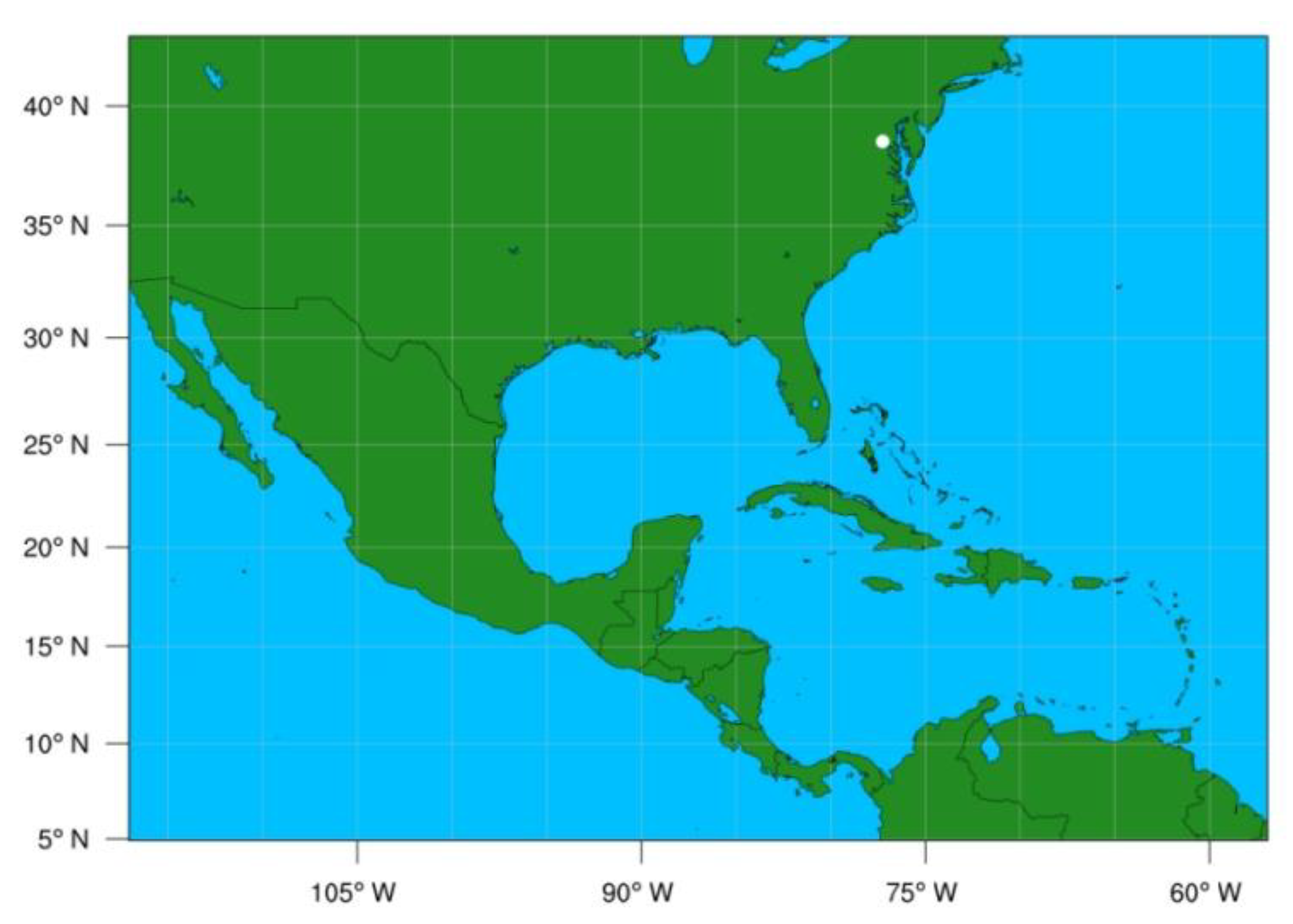
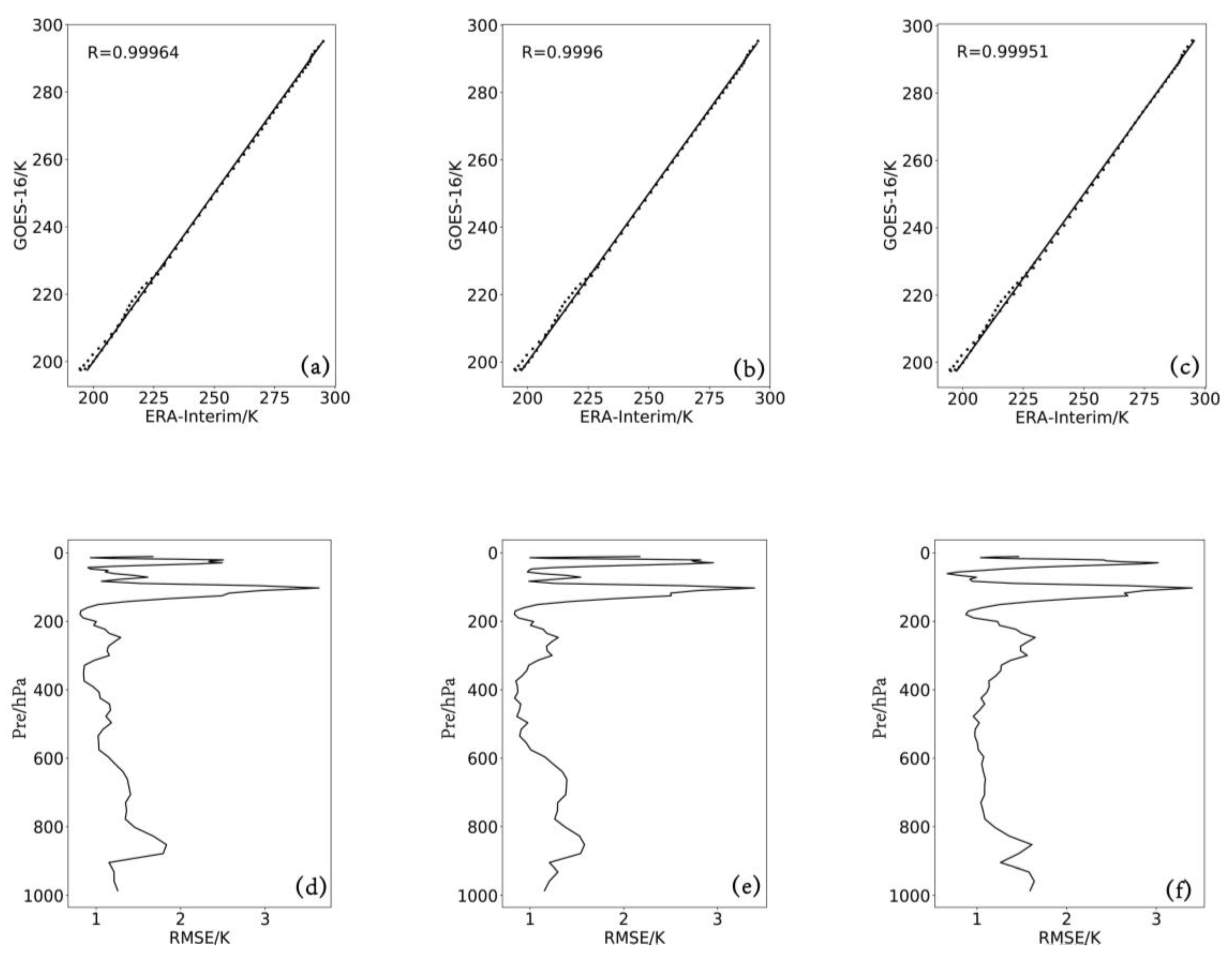

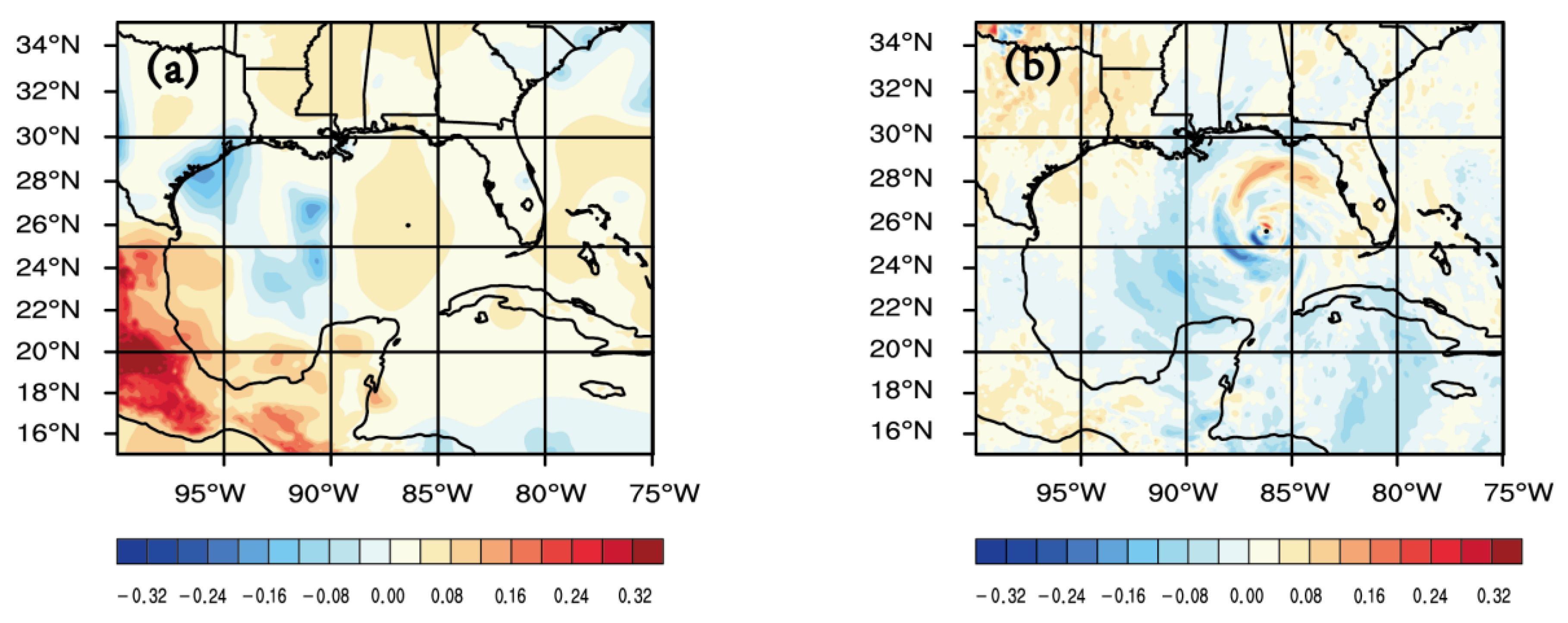
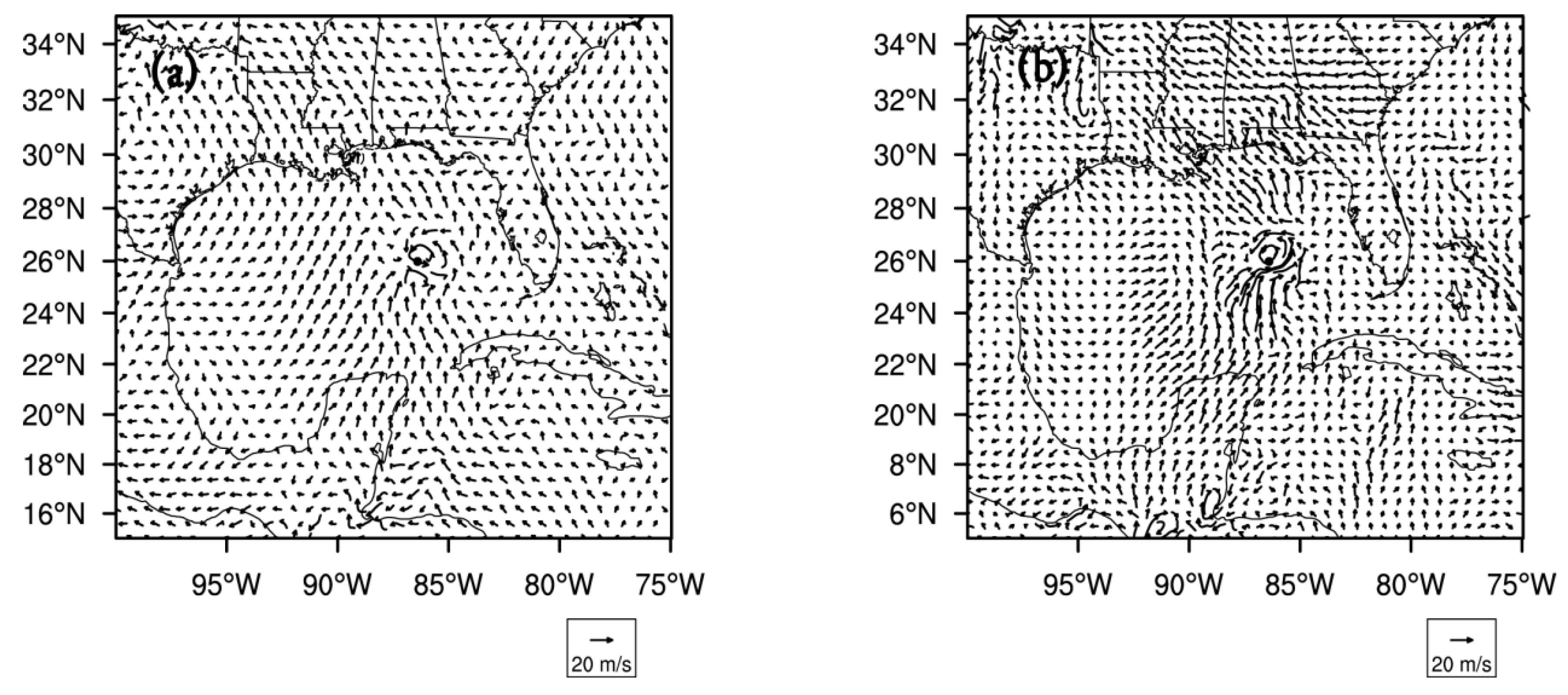

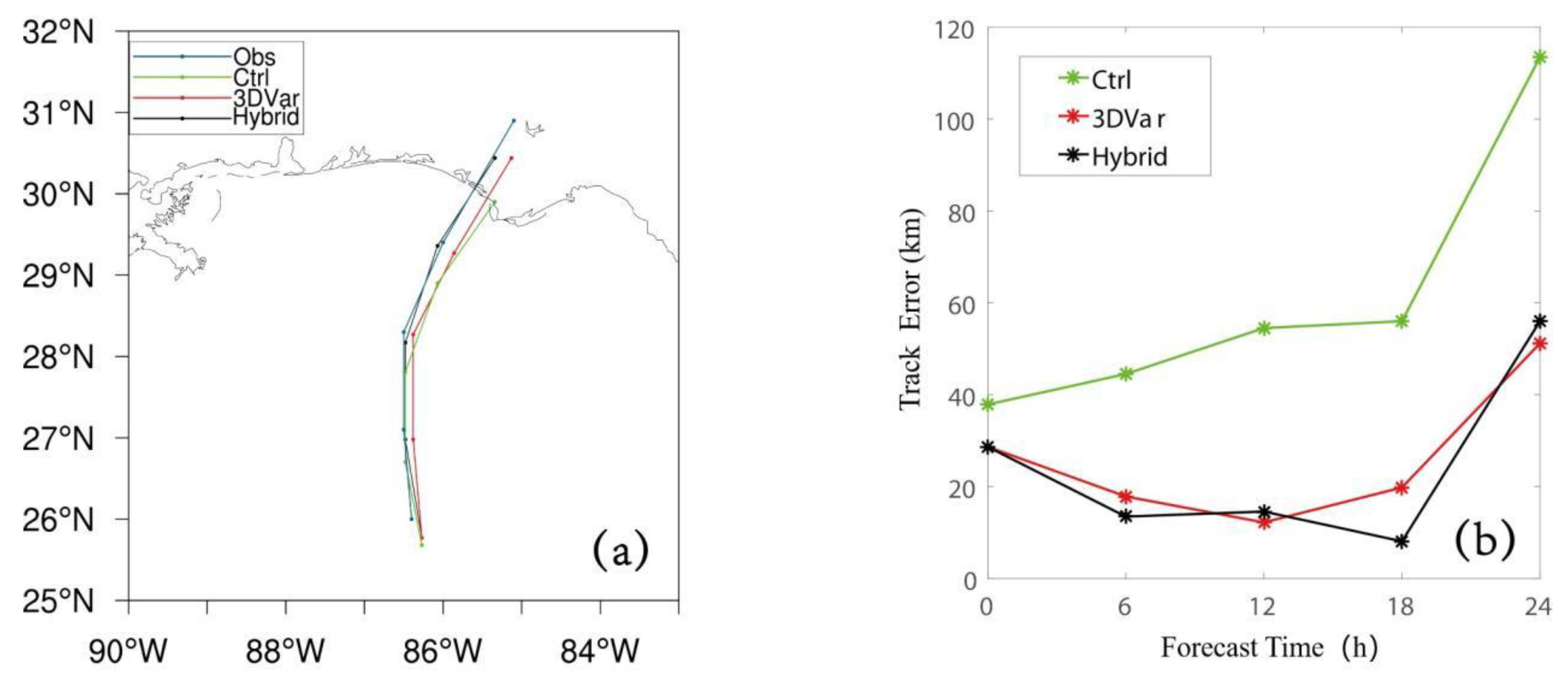
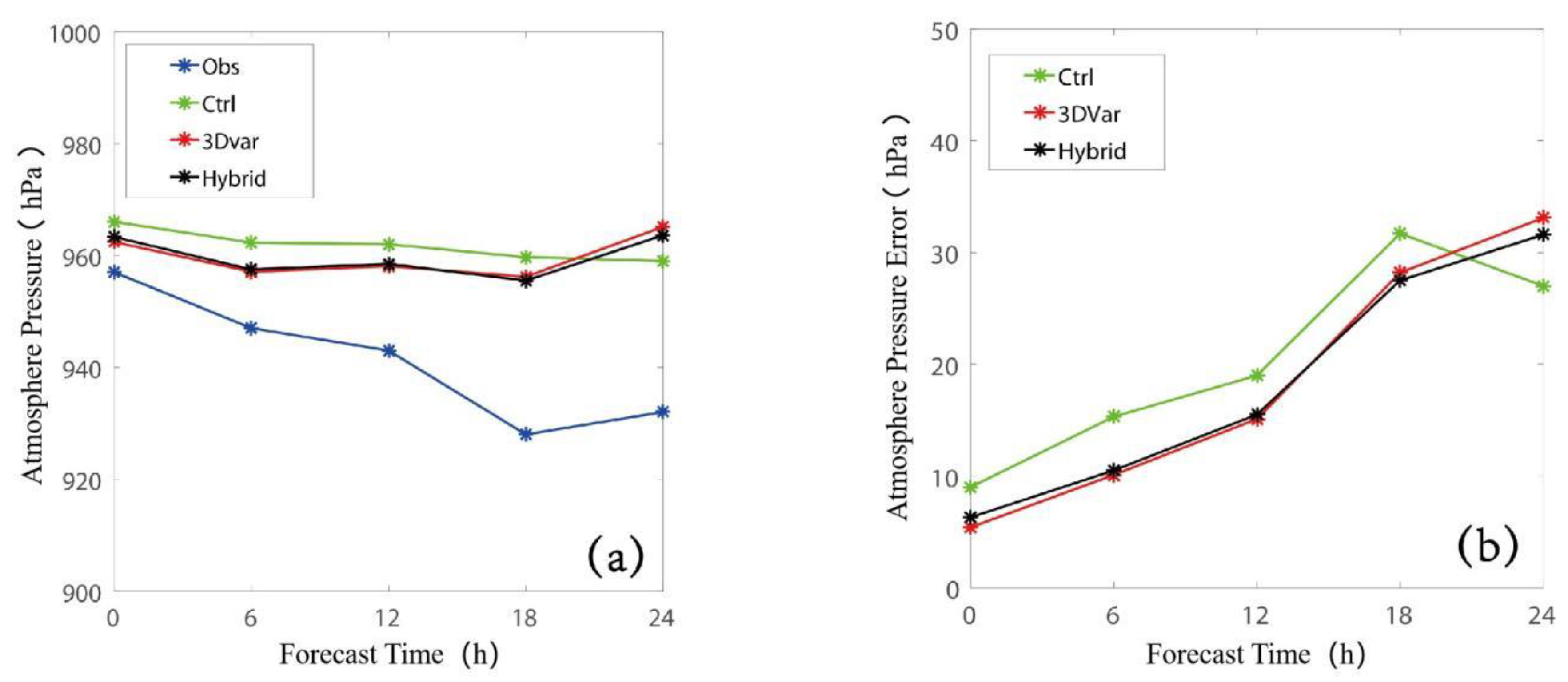
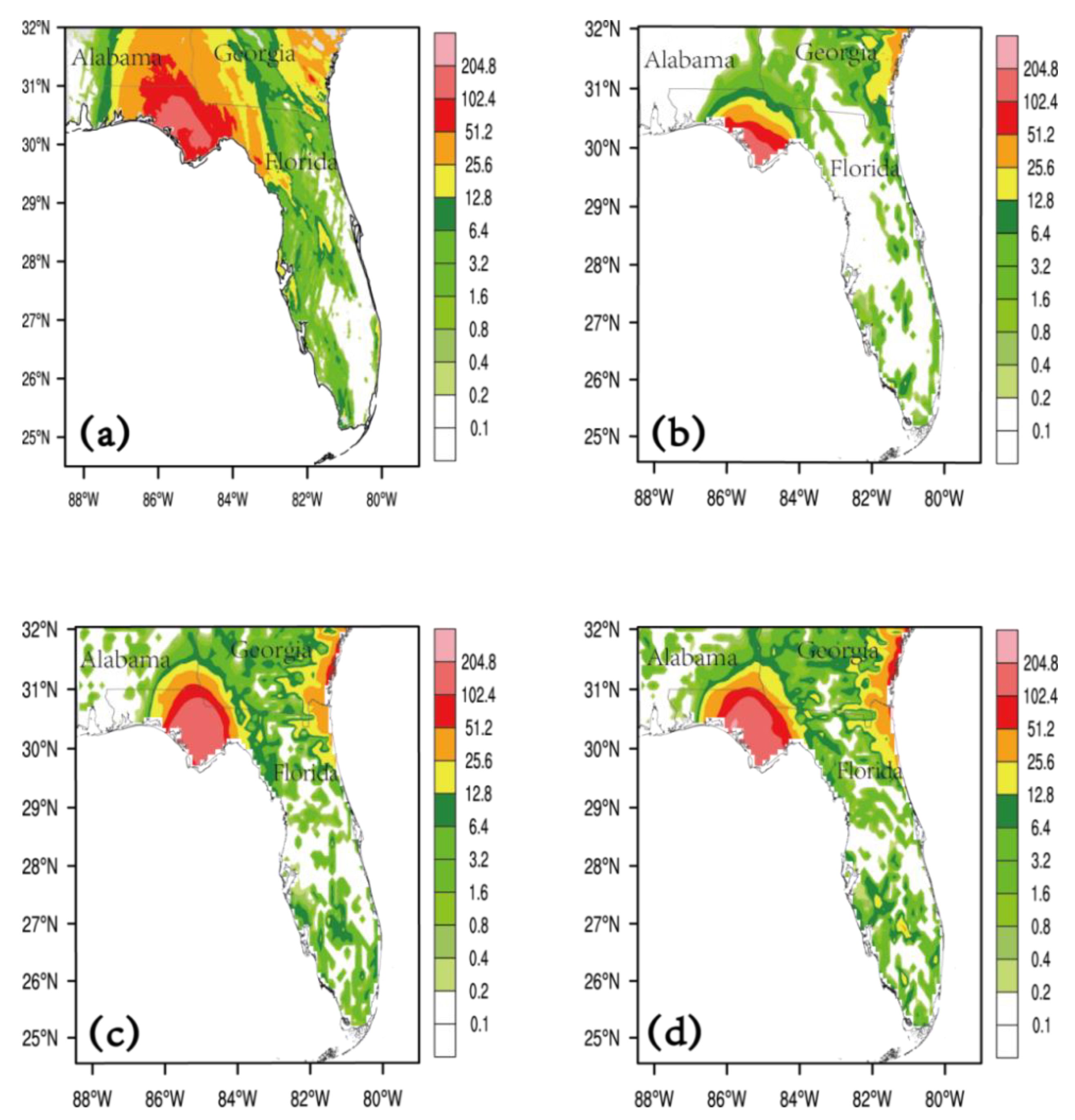
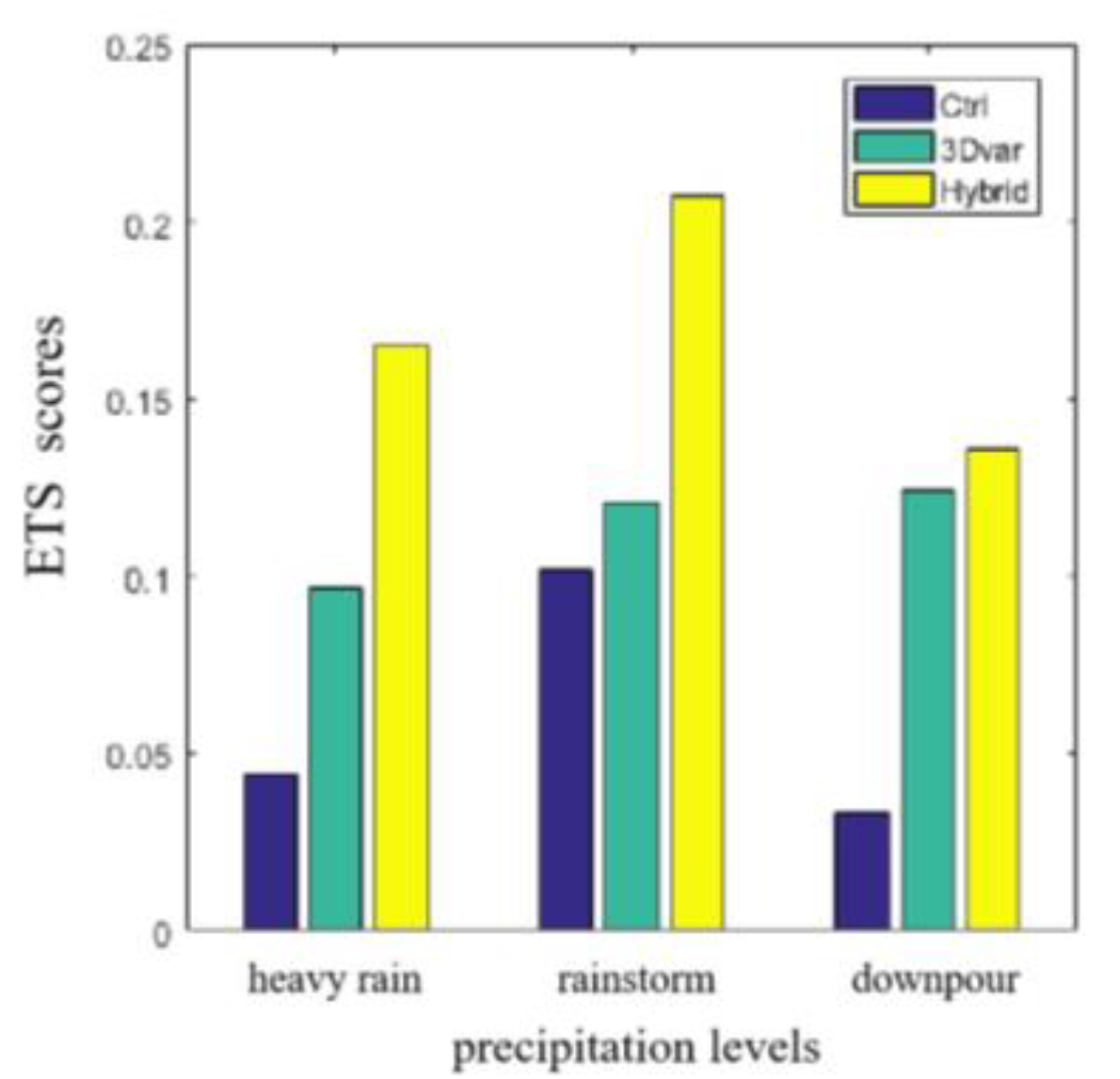
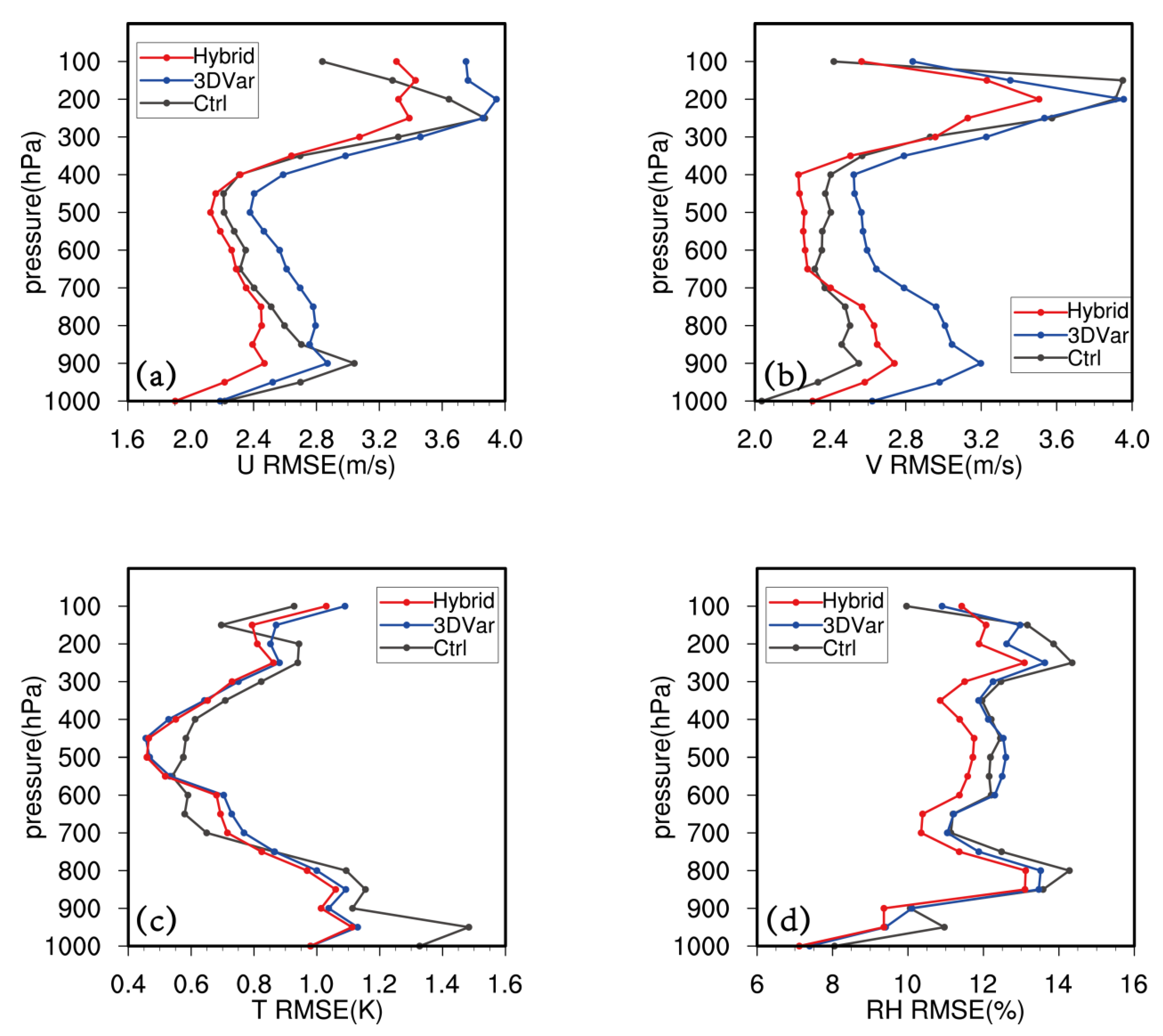
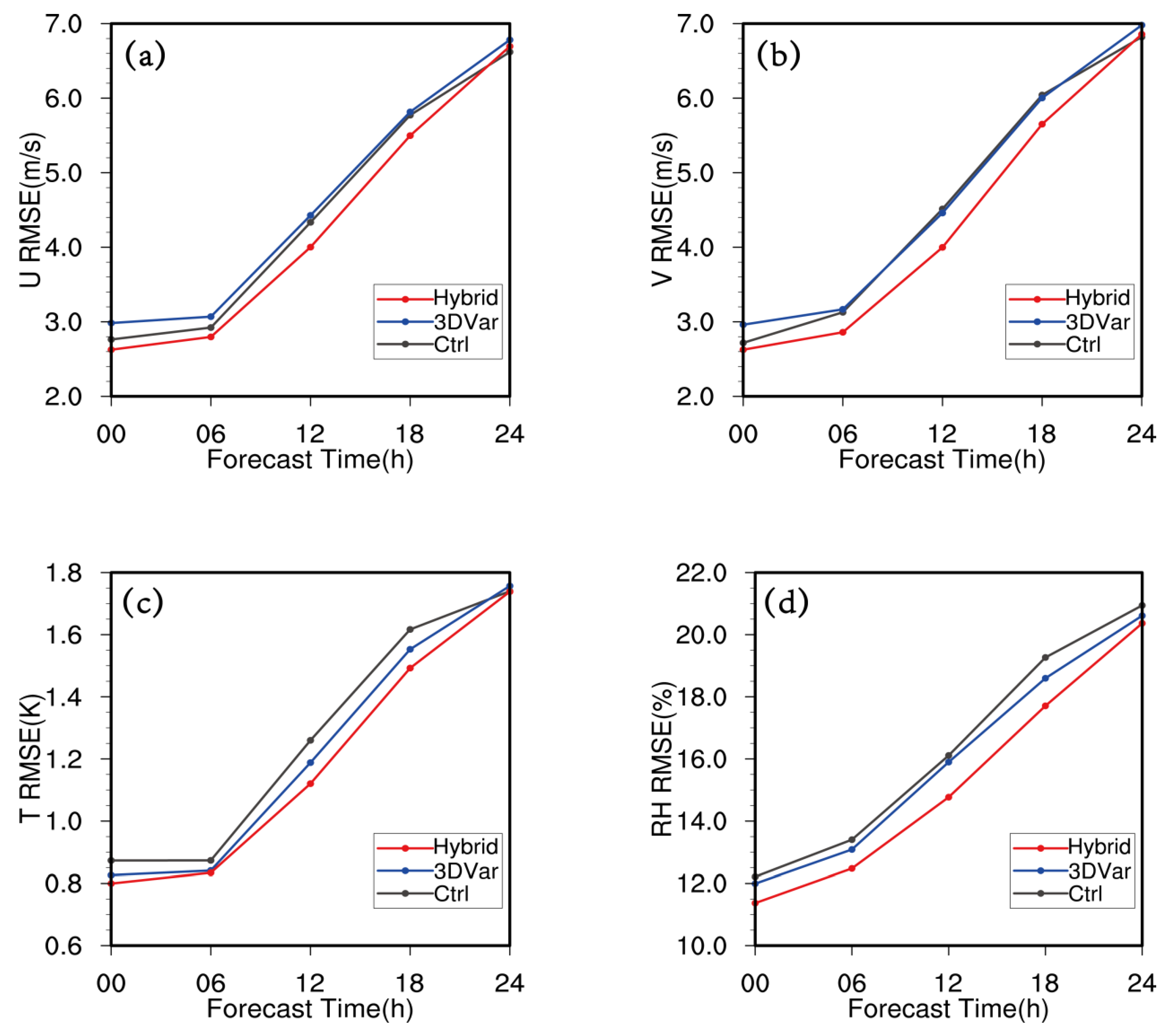
| Serial Number | Experiment Name | Experiment Method |
|---|---|---|
| 1 | The Ctrl | Do not assimilate any observations; the integration period is from 00:00 on 9 October to 18:00 on 10 October |
| 2 | The 3DVar | Adopt the 3VAR assimilation system, and the background-error covariance is constructed using the NMC method, spin-up 6 h from 00:00 on 9 October to 06:00 on 9 October, cycle assimilation until 18:00 on 9 October, and then integrates until 18:00 on 10 October |
| 3 | The Hybrid | Adopt the Hybrid assimilation system, take 50 ensemble members, and use the ETKF method to update the members; the mixing coefficient is taken as 0.5. Same as 2. After the cycle of assimilation, the integration ends at 18:00 on 10 October. |
Disclaimer/Publisher’s Note: The statements, opinions and data contained in all publications are solely those of the individual author(s) and contributor(s) and not of MDPI and/or the editor(s). MDPI and/or the editor(s) disclaim responsibility for any injury to people or property resulting from any ideas, methods, instructions or products referred to in the content. |
© 2023 by the authors. Licensee MDPI, Basel, Switzerland. This article is an open access article distributed under the terms and conditions of the Creative Commons Attribution (CC BY) license (https://creativecommons.org/licenses/by/4.0/).
Share and Cite
Qian, Z.; Bao, Y.; Liu, Z.; Lu, Q.; Wang, F.; Tang, W. Application of GOES-16 Atmospheric Temperature-Profile Data Assimilation in a Hurricane Forecast. Atmosphere 2023, 14, 1757. https://doi.org/10.3390/atmos14121757
Qian Z, Bao Y, Liu Z, Lu Q, Wang F, Tang W. Application of GOES-16 Atmospheric Temperature-Profile Data Assimilation in a Hurricane Forecast. Atmosphere. 2023; 14(12):1757. https://doi.org/10.3390/atmos14121757
Chicago/Turabian StyleQian, Zhiying, Yansong Bao, Zirui Liu, Qifeng Lu, Fu Wang, and Weiyao Tang. 2023. "Application of GOES-16 Atmospheric Temperature-Profile Data Assimilation in a Hurricane Forecast" Atmosphere 14, no. 12: 1757. https://doi.org/10.3390/atmos14121757
APA StyleQian, Z., Bao, Y., Liu, Z., Lu, Q., Wang, F., & Tang, W. (2023). Application of GOES-16 Atmospheric Temperature-Profile Data Assimilation in a Hurricane Forecast. Atmosphere, 14(12), 1757. https://doi.org/10.3390/atmos14121757








